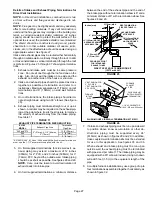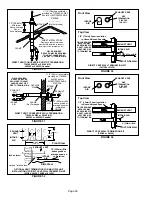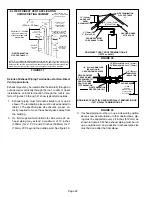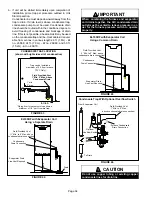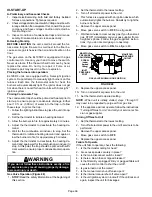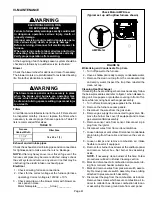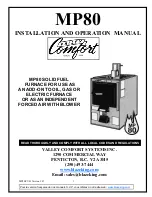
Page 41
VI−MAINTENANCE
WARNING
ELECTRICAL SHOCK, FIRE,
OR EXPLOSION HAZARD.
Failure to follow safety warnings exactly could result
in dangerous operation, serious injury, death or
property damage.
Improper servicing could result in dangerous opera-
tion, serious injury, death, or property damage.
Before servicing, disconnect all electrical power to
furnace.
When servicing controls, label all wires prior to dis-
connecting. Take care to reconnect wires correctly.
Verify proper operation after servicing.
At the beginning of each heating season, system should be
checked as follows by a qualified service technician:
Blower
Check the blower wheel for debris and clean if necessary.
The blower motors are prelubricated for extended bearing
life. No further lubrication is needed.
WARNING
The blower access panel must be securely in place
when the blower and burners are operating. Gas
fumes, which could contain carbon monoxide, can
be drawn into living space resulting in personal inju-
ry or death.
Filters
All air filters are installed external to the unit. Filters should
be inspected monthly. Clean or replace the filters when
necessary to ensure proper furnace operation. Table 18
lists recommended filter sizes.
TABLE 18
Furnace
Cabinet Width
Filter Size
16 x 25 x 1 (1)
17−1/2"
21"
Exhaust and air intake pipes
Check the exhaust and air intake pipes and all connections
for tightness and to make sure there is no blockage.
NOTE
− After any heavy snow, ice or frozen fog event the
furnace vent pipes may become restricted. Always check
the vent system and remove any snow or ice that may be
obstructing the plastic intake or exhaust pipes.
Electrical
1 − Check all wiring for loose connections.
2 − Check for the correct voltage at the furnace (furnace
operating). Correct voltage is 10%
3 − Check amp−draw on the blower motor with blower ac-
cess panel in place.
Motor Nameplate__________Actual__________
FIGURE 54
Check Motor AMP Draw
(Typical set
−
up with upflow furnace shown)
kVAr
kWh
COM
M
V3
V1 V2
POFF
MR
EX
1
W
3
2
AMP Meter
Winterizing and Condensate Trap Care
1 − Turn off power to the furnace.
2 − Have a shallow pan ready to empty condensate water.
3 − Remove the clean out cap from the condensate trap
and empty water. Inspect the trap then reinstall the
clean out cap.
Cleaning Heat Exchanger
If cleaning the heat exchanger becomes necessary, follow
the below procedures and refer to figure 1 when disassem-
bling unit. Use papers or protective covering in front of fur-
nace while removing heat exchanger assembly.
1 − Turn off electrical and gas supplies to the furnace.
2 − Remove the furnace access panels.
3 − Disconnect the wires from the gas valve.
4 − Remove gas supply line connected to gas valve. Re-
move the burner box cover (if equipped) and remove
gas valve/manifold assembly.
5 − Remove sensor wire from sensor. Disconnect 2-pin
plug from the ignitor.
6 − Disconnect wires from flame roll−out switches.
7 − Loosen clamps at vent elbow. Disconnect condensate
drain tubing from flue collar. and remove the vent el-
bow.
8 − Loosen clamps and remove combustion air intake
flexible connector if equipped.
9 − Remove four burner box screws at the vestibule panel
and remove burner box. Set burner box assembly
aside.
NOTE
− If necessary, clean burners at this time. Follow
procedures outlined in Burner Cleaning section.
10 − Mark and disconnect all combustion air pressure tub-
ing from cold end header collector box.
11 − Mark and remove wires from pressure switch assem-
bly. Remove pressure switch assembly. Keep tubing
attached to pressure switch assembly.
12 − Disconnect the plug from the combustion air inducer.
Remove two screws which secure combustion air in-
ducer to collector box. Remove combustion air induc-
er assembly. Remove ground wire from vest panel.

